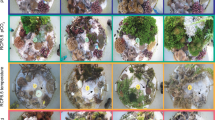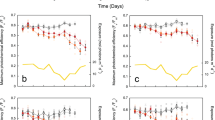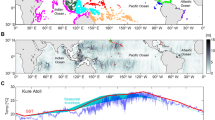Abstract
Elevated sea surface temperatures have been shown to cause mass coral bleaching1,2,3. Widespread bleaching, affecting >90% of global coral reefs and causing coral degradation, has been projected to occur by 2050 under all climate forcing pathways adopted by the IPCC for use within the Fifth Assessment Report4,5. These pathways include an extremely ambitious pathway aimed to limit global mean temperature rise to 2 °C (ref. 6; Representative Concentration Pathway 2.6—RCP2.6), which assumes full participation in emissions reductions by all countries, and even the possibility of negative emissions7. The conclusions drawn from this body of work, which applied widely used algorithms to estimate coral bleaching8, are that we must either accept that the loss of a large percentage of the world’s coral reefs is inevitable, or consider technological solutions to buy those reefs time until atmospheric CO2 concentrations can be reduced. Here we analyse the potential for geoengineering, through stratospheric aerosol-based solar radiation management (SRM), to reduce the extent of global coral bleaching relative to ambitious climate mitigation. Exploring the common criticism of geoengineering—that ocean acidification and its impacts will continue unabated—we focus on the sensitivity of results to the aragonite saturation state dependence of bleaching. We do not, however, address the additional detrimental impacts of ocean acidification on processes such as coral calcification9,10 that will further determine the benefit to corals of any SRM-based scenario. Despite the sensitivity of thermal bleaching thresholds to ocean acidification being uncertain11,12, stabilizing radiative forcing at 2020 levels through SRM reduces the risk of global bleaching relative to RCP2.6 under all acidification–bleaching relationships analysed.
This is a preview of subscription content, access via your institution
Access options
Subscribe to this journal
Receive 12 print issues and online access
$209.00 per year
only $17.42 per issue
Buy this article
- Purchase on Springer Link
- Instant access to full article PDF
Prices may be subject to local taxes which are calculated during checkout




Similar content being viewed by others
References
Brown, B. E. Coral bleaching: Causes and consequences. Coral Reefs 16, S129–S138 (1997).
Edwards, A. J. et al. Coral bleaching and mortality on artificial and natural reefs in Maldives in 1998, sea surface temperature anomalies and initial recovery. Mar. Pollut. Bull. 42, 7–15 (2001).
Hoegh-Guldberg, O. Climate change, coral bleaching and the future of the world’s coral reefs. Mar. Freshwat. Res. 50, 839–866 (1999).
Frieler, K. et al. Limiting global warming to 2 °C is unlikely to save most coral reefs. Nature Clim. Change 3, 165–170 (2013).
Van Hooidonk, R., Maynard, J. A. & Planes, S. Temporary refugia for coral reefs in a warming world. Nature Clim. Change 3, 508–511 (2013).
Vuuren, D. et al. The representative concentration pathways: An overview. Climatic Change 109, 5–31 (2011).
Jones, C. et al. Twenty-first-century compatible CO2 emissions and airborne fraction simulated by CMIP5 earth system models under four representative concentration pathways. J. Clim. 26, 4398–4413 (2013).
Strong, A. E., Liu, G., Skirving, W. & Eakin, C. M. NOAA’s Coral Reef Watch program from satellite observations. Ann. GIS 17, 83–92 (2011).
Langdon, C. & Atkinson, M. J. Effect of elevated p CO 2 on photosynthesis and calcification of corals and interactions with seasonal change in temperature/irradiance and nutrient enrichment. J. Geophys. Res. 110, C09S07 (2005).
Chan, N. C. S. & Connolly, S. R. Sensitivity of coral calcification to ocean acidification: A meta-analysis. Glob. Change Biol. 19, 282–290 (2013).
Anthony, K. R. N., Kline, D. I., Diaz-Pulido, G., Dove, S. & Hoegh-Guldberg, O. Ocean acidification causes bleaching and productivity loss in coral reef builders. Proc. Natl Acad. Sci. USA 105, 17442–17446 (2008).
Wall, C. B., Fan, T-Y. & Edmunds, P. J. Ocean acidification has no effect on thermal bleaching in the coral Seriatopora caliendrum. Coral Reefs 33, 119–130 (2013).
Moberg, F. & Folke, C. Ecological goods and services of coral reef ecosystems. Ecol. Econ. 29, 215–233 (1999).
Enriquez, S., Mendez, E. R. & Iglesias-Prieto, R. Multiple scattering on coral skeletons enhances light absorption by symbiotic algae. Limnol. Oceanogr. 50, 1025–1032 (2005).
Rasch, P. J. et al. An overview of geoengineering of climate using stratospheric sulphate aerosols. Phil. Trans. R. Soc. Math. A 366, 4007–4037 (2008).
Kwiatkowski, L. et al. Caribbean coral growth influenced by anthropogenic aerosol emissions. Nature Geosci. 6, 362–366 (2013).
Ricke, K. L., Orr, J. C., Schneider, K. & Caldeira, K. Risks to coral reefs from ocean carbonate chemistry changes in recent earth system model projections. Environ. Res. Lett. 8, 034003 (2013).
Mumby, P. J. & van Woesik, R. Consequences of ecological, evolutionary and biogeochemical uncertainty for coral reef responses to climatic stress. Curr. Biol. 24, R413–R423 (2014).
Collins, W. J. et al. Development and evaluation of an Earth-system model—HadGEM2. Geosci. Mod. Dev. Discuss. 4, 997–1062 (2011).
Kravitz, B. et al. The geoengineering model intercomparison project (GeoMIP). Atmos. Sci. Lett. 12, 162–167 (2011).
Ortiz, J. C., Bozec, Y-M., Wolff, N. H., Doropoulos, C. & Mumby, P. J. Global disparity in the ecological benefits of reducing carbon emissions for coral reefs. Nature Clim. Change 4, 1090–1094 (2014).
Kwiatkowski, L., Halloran, P. R., Mumby, P. J. & Stephenson, D. B. What spatial scales are believable for climate model projections of sea surface temperature? Clim. Dynam. 43, 1483–1496 (2014).
Donner, S. D. Coping with commitment: Projected thermal stress on coral reefs under different future scenarios. PLoS ONE 4, e5712 (2009).
Couce, E., Irvine, P. J., Gregoire, L. J., Ridgwell, A. & Hendy, E. J. Tropical coral reef habitat in a geoengineered, high-CO2 world. Geophys. Res. Lett. 40, 1799–1805 (2013).
Kennedy, E. V. et al. Avoiding coral reef functional collapse requires local and global action. Curr. Biol. 23, 912–918 (2013).
Silverman, J., Lazar, B., Cao, L., Caldeira, K. & Erez, J. Coral reefs may start dissolving when atmospheric CO2 doubles. Geophys. Res. Lett. 36, L05606 (2009).
McCulloch, M., Falter, J., Trotter, J. & Montagna, P. Coral resilience to ocean acidification and global warming through pH up-regulation. Nature Clim. Change 2, 623–627 (2012).
Cao, L., Zhang, H., Zheng, M. & Wang, S. Response of ocean acidification to a gradual increase and decrease of atmospheric CO2 . Environ. Res. Lett. 9, 024012 (2014).
Acknowledgements
We thank J. Orr, D. Long and I. Chollett for assistance with data processing. The study was financially supported by a NERC grant to P.J.M. and P.C., the University of Exeter, and the EU FORCE project and was supported by the Joint DECC/Defra Met Office Hadley Centre Climate Programme.
Author information
Authors and Affiliations
Contributions
L.K., P.C. and P.R.H. designed and conducted the research and analysis. A.J.W. and P.R.H. performed the HadGEM2-ES simulations. L.K., P.C., P.R.H., A.J.W. and P.J.M. wrote the paper.
Corresponding author
Ethics declarations
Competing interests
The authors declare no competing financial interests.
Supplementary information
Rights and permissions
About this article
Cite this article
Kwiatkowski, L., Cox, P., Halloran, P. et al. Coral bleaching under unconventional scenarios of climate warming and ocean acidification. Nature Clim Change 5, 777–781 (2015). https://doi.org/10.1038/nclimate2655
Received:
Accepted:
Published:
Issue Date:
DOI: https://doi.org/10.1038/nclimate2655
This article is cited by
-
Systematic review of the uncertainty of coral reef futures under climate change
Nature Communications (2024)
-
Importance of depth and temperature variability as drivers of coral symbiont composition despite a mass bleaching event
Scientific Reports (2023)
-
Culling corallivores improves short-term coral recovery under bleaching scenarios
Nature Communications (2022)
-
Mass spectrometry–based metabolomic signatures of coral bleaching under thermal stress
Analytical and Bioanalytical Chemistry (2022)
-
Potential implications of solar radiation modification for achievement of the Sustainable Development Goals
Mitigation and Adaptation Strategies for Global Change (2021)



